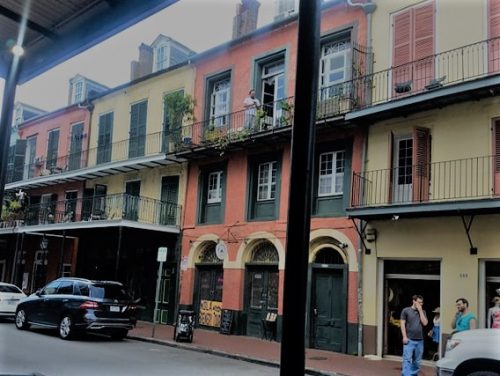



Photos: Buildings in downtown, French Quarter, and Beignets
I remember the first time my ears took in the raspy voice of the legendary Louis “Satchmo” Armstrong. The harmony of clarinet and trumpet permeated my Kindergarten classroom alongside the lyrics of his most popular song: “What a Wonderful World.”
With the ability to serenade the mind of both a curious five-year-old girl and an ambitious now twenty-one-year-old woman, he sang from the depths of his New Orleans heritage and his songs mirrored the vivacious city that is New Orleans (NOLA), Louisiana.
I remember promenading around the French Quarter on day two and thinking “oh, we’re in the South South!” where greeting strangers wasn’t abnormal and good food became the topic of most discussions. Our friendly taxi driver, Joseph, summed up the heart of NOLA living in one sentence: “Cooking, drinking, and music…that’s all we need!” The words “Gumbo”, “Jambalaya”, and “seafood” rolled off of every tongue and blessed my taste buds, with stories of grandma’s cooking and everyone claiming their grandma made it best. NOLA is to be seen and tasted, where the heat of the Cajun and Creole seasoning contrasts with the sweet, powder-covered beignets at Café du Monde.
The sun seems to sit closer to this city, baking the air like a furnace while evaporating water from the nearby Mississippi, causing beads of sweat to rain down my face like the spontaneous “midday monsoons” that leave your clothes drenched and the streets flooded.
I was surprised to learn that I preferred streetcars over buses, so every day after leaving my internship placement, I’d push my way onto the clunky cars so I could feel the breeze on my sticky skin and stare at the passing scenery. As downtown skyscrapers transitioned into various pastel-colored mansions, I marveled at the art that is NOLA.
As enticing and art-filled as NOLA is, I quickly learned that it is a city of dichotomies. On one street you see mansions, but on another, you find boarded-up homes in neighborhoods where communities still struggle to recover from Hurricane Katrina in 2005. Beads draped over the branches of trees reveal residue from Mardi-Gras, but around the corner and under the bridge you see the homeless population draped in blankets, like the neglected residue of poverty, housing, racial, and economic inequality.
“When Katrina hit…” is a familiar phrase, often accompanied by devastating stories of 14-foot waters, families stranded on roofs, and years of reconstruction. I was informed by my program director that Katrina “did not discriminate,” wreaking havoc on residents of all kinds; public health programs are in focus as education, healthcare, and public transportation are only three broad categories of the many systems that are in need of reform.
Despite the cracks, many people are born, bred, and buried in this great city.
The force of Katrina was met with a resilience twice as strong; parades fill the streets where floodwaters once did, and the beats of makeshift bucket drums compete with the rolling thunder of a midday monsoon.
With new knowledge, I hear the gravelly voice of the great Satchmo with new ears. I now understand the muse behind his melodies as he states, “Every time I close my eyes blowing that trumpet of mine, I look right into the heart of good old New Orleans. It has given me something to live for.”
